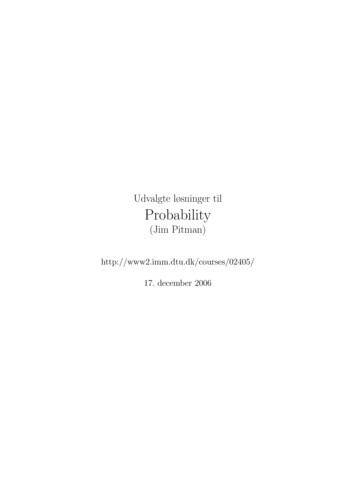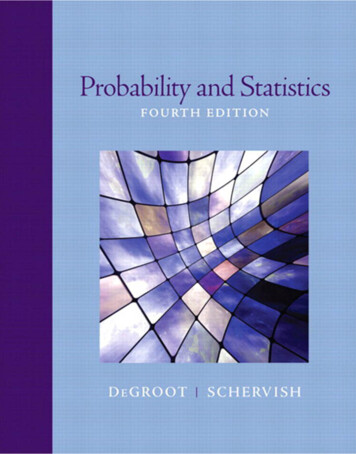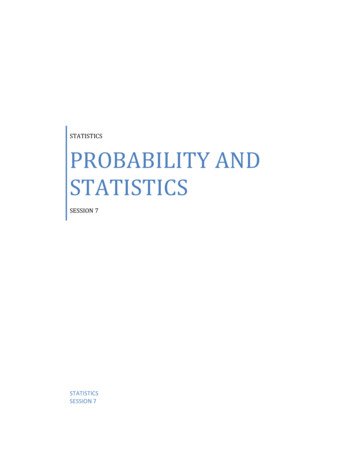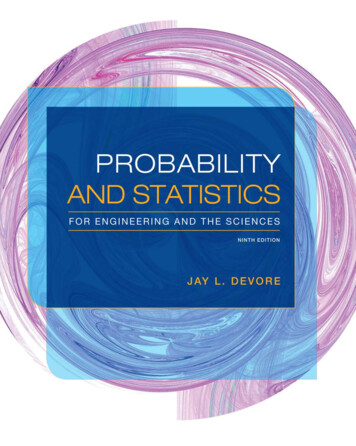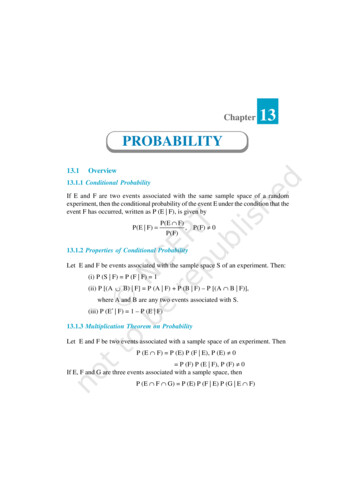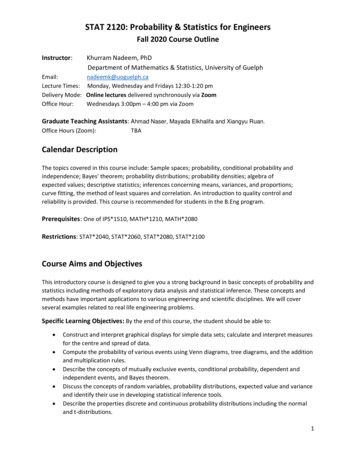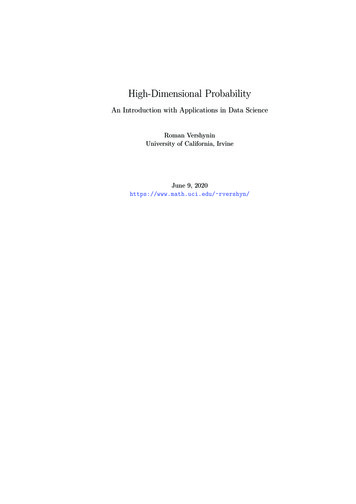
Transcription
High-Dimensional ProbabilityAn Introduction with Applications in Data ScienceRoman VershyninUniversity of California, IrvineJune 9, 2020https://www.math.uci.edu/ rvershyn/
ContentsPrefaceAppetizer: using probability to cover a geometric setvi111.11.21.31.4Preliminaries on random variablesBasic quantities associated with random variablesSome classical inequalitiesLimit centration of sums of independent random variablesWhy concentration inequalities?Hoeffding’s inequalityChernoff’s inequalityApplication: degrees of random graphsSub-gaussian distributionsGeneral Hoeffding’s and Khintchine’s inequalitiesSub-exponential distributionsBernstein’s 53.63.73.8Random vectors in high dimensionsConcentration of the normCovariance matrices and principal component analysisExamples of high-dimensional distributionsSub-gaussian distributions in higher dimensionsApplication: Grothendieck’s inequality and semidefinite programmingApplication: Maximum cut for graphsKernel trick, and tightening of Grothendieck’s .6Random matricesPreliminaries on matricesNets, covering numbers and packing numbersApplication: error correcting codesUpper bounds on random sub-gaussian matricesApplication: community detection in networksTwo-sided bounds on sub-gaussian matrices76768186899397iii
ivContents4.74.8Application: covariance estimation and ration without independenceConcentration of Lipschitz functions on the sphereConcentration on other metric measure spacesApplication: Johnson-Lindenstrauss LemmaMatrix Bernstein’s inequalityApplication: community detection in sparse networksApplication: covariance estimation for general .36.46.56.66.76.8Quadratic forms, symmetrization and contractionDecouplingHanson-Wright InequalityConcentration of anisotropic random vectorsSymmetrizationRandom matrices with non-i.i.d. entriesApplication: matrix completionContraction 37.47.57.67.77.8Random processesBasic concepts and examplesSlepian’s inequalitySharp bounds on Gaussian matricesSudakov’s minoration inequalityGaussian widthStable dimension, stable rank, and Gaussian complexityRandom projections of .58.68.78.8ChainingDudley’s inequalityApplication: empirical processesVC dimensionApplication: statistical learning theoryGeneric chainingTalagrand’s majorizing measure and comparison theoremsChevet’s .39.49.5Deviations of random matrices and geometric consequencesMatrix deviation inequalityRandom matrices, random projections and covariance estimationJohnson-Lindenstrauss Lemma for infinite setsRandom sections: M bound and Escape TheoremNotes229229235238240244
Contents1010.110.210.310.410.510.610.7Sparse RecoveryHigh-dimensional signal recovery problemsSignal recovery based on M boundRecovery of sparse signalsLow-rank matrix recoveryExact recovery and the restricted isometry propertyLasso algorithm for sparse regressionNotes11Dvoretzky-Milman’s Theorem11.1 Deviations of random matrices with respect to general norms11.2 Johnson-Lindenstrauss embeddings and sharper Chevet inequality11.3 Dvoretzky-Milman’s Theorem11.4 269272274279280290
PrefaceWho is this book for?This is a textbook in probability in high dimensions with a view toward applications in data sciences. It is intended for doctoral and advanced masters studentsand beginning researchers in mathematics, statistics, electrical engineering, computational biology and related areas, who are looking to expand their knowledgeof theoretical methods used in modern research in data sciences.Why this book?Data sciences are moving fast, and probabilistic methods often provide a foundation and inspiration for such advances. A typical graduate probability courseis no longer sufficient to acquire the level of mathematical sophistication thatis expected from a beginning researcher in data sciences today. The proposedbook intends to partially cover this gap. It presents some of the key probabilistic methods and results that may form an essential toolbox for a mathematicaldata scientist. This book can be used as a textbook for a basic second course inprobability with a view toward data science applications. It is also suitable forself-study.What is this book about?High-dimensional probability is an area of probability theory that studies randomobjects in Rn where the dimension n can be very large. This book places particular emphasis on random vectors, random matrices, and random projections.It teaches basic theoretical skills for the analysis of these objects, which includeconcentration inequalities, covering and packing arguments, decoupling and symmetrization tricks, chaining and comparison techniques for stochastic processes,combinatorial reasoning based on the VC dimension, and a lot more.High-dimensional probability provides vital theoretical tools for applicationsin data science. This book integrates theory with applications for covarianceestimation, semidefinite programming, networks, elements of statistical learning,error correcting codes, clustering, matrix completion, dimension reduction, sparsesignal recovery, sparse regression, and more.PrerequisitesThe essential prerequisites for reading this book are a rigorous course in probability theory (on Masters or Ph.D. level), an excellent command of undergraduatelinear algebra, and general familiarity with basic notions about metric, normedvi
Prefaceviiand Hilbert spaces and linear operators. Knowledge of measure theory is notessential but would be helpful.A word on exercisesExercises are integrated into the text. The reader can do them immediately tocheck his or her understanding of the material just presented, and to preparebetter for later developments. The difficulty of the exercises is indicated by thenumber of coffee cups; it can range from easiest (K) to hardest (KKKK).Related readingThis book covers only a fraction of theoretical apparatus of high-dimensionalprobability, and it illustrates it with only a sample of data science applications.Each chapter in this book is concluded with a Notes section, which has pointersto other texts on the matter. A few particularly useful sources should be notedhere. The now classical book [8] showcases the probabilistic method in applications to discrete mathematics and computer science. The forthcoming book [20]presents a panorama of mathematical data science, and it particularly focuseson applications in computer science. Both these books are accessible to graduate and advanced undergraduate students. The lecture notes [210] are pitchedfor graduate students and present more theoretical material in high-dimensionalprobability.AcknowledgementsThe feedback from my many colleagues was instrumental in perfecting this book.My special thanks go to Florent Benaych-Georges, Jennifer Bryson, Lukas Grätz,Remi Gribonval, Ping Hsu, Mike Izbicki, Yi Li, George Linderman, Cong Ma,Galyna Livshyts, Jelani Nelson, Ekkehard Schnoor, Martin Spindler, DominikStöger, Tim Sullivan, Terence Tao, Joel Tropp, Katarzyna Wyczesany, Yifei Shenand Haoshu Xu for many valuable suggestions and corrections, especially to Sjoerd Dirksen, Larry Goldstein, Wu Han, Han Wu, and Mahdi Soltanolkotabi fordetailed proofreading of the book, Can Le, Jennifer Bryson and my son IvanVershynin for their help with many pictures in this book.After this book had been published, many colleagues offered further suggestionsand noticed many typos, gaps and inaccuracies. I am grateful to Karthik Abinav,Diego Armentano, Aaron Berk, Soham De, Hu Fu, Adam Jozefiak, Nick Harvey,Harrie Hendriks, Yi Li, Chris Liaw, Hengrui Luo, Sikander Randhawa, KarthikSankararaman, and especially to Aryeh Kontorovich, Jake Knigge, Mark Meckes,Abbas Mehrabian, Holger Rauhut, and Hao Xing who offered substantial feedbackthat lead to significant improvements.The issues that are found after publication have been corrected in the electronicversion. Please feel free to send me any further feedback.Irvine, CaliforniaJune 9, 2020
Appetizer: using probability to cover a geometric setWe begin our study of high-dimensional probability with an elegant argumentthat showcases the usefulness of probabilistic reasoning in geometry.Recall that a convex combination of points z1 , . . . , zm Rn is a linear combination with coefficients that are non-negative and sum to 1, i.e. it is a sum of theformmmXXλi zi where λi 0 andλi 1.(0.1)i 1i 1nThe convex hull of a set T R is the set of all convex combinations of all finitecollections of points in T :conv(T ) : {convex combinations of z1 , . . . , zm T for m N} ;see Figure 0.1 for illustration.Figure 0.1 The convex hull of a set of points representing major U.S. citiesThe number m of elements defining a convex combination in Rn is not restricteda priori. However, the classical Caratheodory’s theorem states that one can alwaystake m n 1.Theorem 0.0.1 (Caratheodory’s theorem). Every point in the convex hull of aset T Rn can be expressed as a convex combination of at most n 1 pointsfrom T .The bound n 1 can not be improved, as it is clearly attained for a simplex T(a set of n 1 points in general position). Suppose, however, that we only want1
2Appetizer: using probability to cover a geometric setto approximate a point x conv(T ) rather than exactly represent it as a convexcombination. Can we do it with fewer than n 1 points? We now show that thisis possible, and actually the number of required points does not need to dependon the dimension n at all!Theorem 0.0.2 (Approximate Caratheodory’s theorem). Consider a set T Rnwhose diameter1 is bounded by 1. Then, for every point x conv(T ) and everyinteger k, one can find points x1 , . . . , xk T such thatx k1Xxjk j 121 .kThere are two reasons why this result is surprising. First, the number of pointsk in convex combinations does not depend on the dimension n. Second, the coefficients of convex combinations can be made all equal. (Note however thatrepetitions among the points xi are allowed.)Proof Our argument is known as the empirical method of B. Maurey.Translating T if necessary, we may assume that not only the diameter but alsothe radius of T is bounded by 1, i.e.ktk2 1for all t T.(0.2)Fix a point x conv(T ) and express it as a convex combination of some vectorsz1 , . . . , zm T as in (0.1). Now, interpret the definition of convex combination(0.1) probabilistically, with λi taking the roles of probabilities. Specifically, wecan define a random vector Z that takes values zi with probabilities λi :P {Z zi } λi ,i 1, . . . , m.(This is possible by the fact that the weights λi are non-negative and sum toone.) ThenEZ mXλi zi x.i 1Consider independent copies Z1 , Z2 , . . . of Z. By the the strong law of largenumbers,k1XZj xk j 1almost surely as k .PkTo get a quantitative form of this result, let us compute the variance of k1 j 1 Zj .(Incidentally, this computation is at the heart of the proof of the weak law of large1The diameter of T is defined as diam(T ) sup{ks tk2 : s, t T }. We assumed that diam(T ) 1 for simplicity. For a general set T , the bound in the theorem changes to diam(T )/ k. Check this!
Appetizer: using probability to cover a geometric set3numbers). We obtainE x k1XZjk j 12 2 kX1(Zj x)Ek2j 12(since E(Zi x) 0)2k1 XE kZj xk22 .k 2 j 1The last identity is just a higher dimensional version of the basic fact that thevariance of a sum of independent random variables equals the sum of variances;see Exercise 0.0.3 below.It remains to bound the variances of the terms. We haveEkZj xk22 E kZ E Zk22 E kZk22 k E Zk22 (another variance identity; see Exercise 0.0.3) E kZk22 1 (since Z T and using (0.2)).We showed thatE x k1XZjk j 12 21.kTherefore, there exists a realization of the random variables Z1 , . . . , Zk such thatx k1XZjk j 12 21.kSince by construction each Zj takes values in T , the proof is complete.Exercise 0.0.3. KK Check the following variance identities that we used inthe proof of Theorem 0.0.2.(a) Let Z1 , . . . , Zk be independent mean zero random vectors in Rn . Show thatEkXj 12Zj 2kXE kZj k22 .j 1(b) Let Z be a random vector in Rn . Show thatE kZ E Zk22 E kZk22 k E Zk22 .Let us give one application of Theorem 0.0.2 in computational geometry. Suppose we are given a subset P Rn and ask to cover it by balls of given radiusε, see Figure 0.2. What is the smallest number of balls needed, and how shall weplace them?Corollary 0.0.4 (Covering polytopes by balls). Let P be a polytope in Rn withN vertices and whose diameter is bounded by 1. Then P can be covered by at2most N d1/ε e Euclidean balls of radii ε 0.
4Appetizer: using probability to cover a geometric setFigure 0.2 The covering problem asks how many balls of radius ε areneeded to cover a given set in Rn , and where to place these balls.Proof Let us define the centers of the balls as follows. Let k : d1/ε2 e andconsider the setkn1 XoN : xj : xj are vertices of P .k j 1We claim that the family of ε-balls centered at N satisfy the conclusion of thecorollary. To check this, note that the polytope P is the convex hull of the setof its vertices, which we denote by T . Thus we can apply Theorem 0.0.2 to anypoint x P conv(T ) and deduce that x is within distance 1/ k ε fromsome point in N . This shows that the ε-balls centered at N indeed cover P .To bound the cardinality of N , note that there are N k ways to choose k out of2N vertices with repetition. Thus N N k N d1/ε e . The proof is complete.In this book we learn several other approaches to the covering problem when werelate it to packing (Section 4.2), entropy and coding (Section 4.3) and randomprocesses (Chapters 7–8).To finish this section, let us show how to slightly improve Corollary 0.0.4.Exercise 0.0.5 (The sum of binomial coefficients). KK Prove the inequalities!!m en m n mXnn mmkmk 0for all integers m [1, n].Hint: To prove the upper bound, multiply both sides by the quantity (m/n)m , replace this quantity by(m/n)k in the left side, and use the Binomial Theorem.Exercise 0.0.6 (Improved covering). KKCheck that in Corollary 0.0.4,(C Cε2 N )d1/ε2esuffice. Here C is a suitable absolute constant. (Note that this bound is slightly2stronger than N d1/ε e for small ε.)Hint: The number of ways to choose k elements from an N -element set with repetitions isSimplify using Exercise 0.0.5.N k 1k .
Appetizer: using probability to cover a geometric set50.0.1 NotesIn this section we gave an illustration of the probabilistic method, where oneemploys randomness to construct a useful object. The book [8] presents manyillustrations of the probabilistic method, mainly in combinatorics.The empirical method of B. Maurey we presented in this section was originallyproposed in [164]. B. Carl used it to get bounds on covering numbers [49] includingthose stated in Corollary 0.0.4 and Exercise 0.0.6. The bound in Exercise 0.0.6 issharp [49, 50].
1Preliminaries on random variablesIn this chapter we recall some basic concepts and results of probability theory. Thereader should already be familiar with most of this material, which is routinelytaught in introductory probability courses.Expectation, variance, and moments of random variables are introduced inSection 1.1. Some classical inequalities can be found in Section 1.2. The twofundamental limit theorems of probability – the law of large numbers and thecentral limit theorem – are recalled in Section 1.3.1.1 Basic quantities associated with random variablesIn a basic course in probability theory, we learned about the two most importantquantities associated with a random variable X, namely the expectation1 (alsocalled mean), and variance. They will be denoted in this book by2EXandVar(X) E(X E X)2 .Let us recall some other classical quantities and functions that describe probability distributions. The moment generating function of X is defined asMX (t) E etX ,t R.For p 0, the p-th moment of X is defined as E X p , and the p-th absolute momentis E X p .It is useful to take p-th root of the moments, which leads to the notion of theLp norm of a random variable:kXkLp (E X p )1/p ,p (0, ).This definition can be extended to p by the essential supremum of X :kXkL ess sup X .For fixed p and a given probability space (Ω, Σ, P), the classical vector space12If you studied measure theory, you will recall that the expectation E X of a random variable X on aprobability space (Ω, Σ, P) is, by definition, the Lebesgue integral of the function X : Ω R. Thismakes all theorems on Lebesgue integration applicable in probability theory, for expectations ofrandom variables.Throughout this book, we drop the brackets in the notation E[f (X)] and simply write E f (X)instead. Thus, nonlinear functions bind before expectation.6
1.2 Some classical inequalities7Lp Lp (Ω, Σ, P) consists of all random variables X on Ω with finite Lp norm,that is Lp X : kXkLp .If p [1, ], the quantity kXkLp is a norm and Lp is a Banach space. Thisfact follows from Minkowski’s inequality, which we recall in (1.4). For p 1, thetriangle inequality fails and kXkLp is not a norm.The exponent p 2 is special in that L2 is not only a Banach space but also aHilbert space. The inner product and the corresponding norm on L2 are given byhX, Y iL2 E XY,kXkL2 (E X 2 )1/2 .(1.1)Then the standard deviation of X can be expressed asqkX E XkL2 Var(X) σ(X).Similarly, we can express the covariance of random variables of X and Y ascov(X, Y ) E(X E X)(Y E Y ) hX E X, Y E Y iL2 .(1.2)Remark 1.1.1 (Geometry of random variables). When we consider random variables as vectors in the Hilbert space L2 , the identity (1.2) gives a geometric interpretation of the notion of covariance. The more the vectors X E X and Y E Yare aligned with each other, the bigger their inner product and covariance are.1.2 Some classical inequalitiesJensen’s inequality states that for any random variable X and a convex3 functionϕ : R R, we haveϕ(E X) E ϕ(X).As a simple consequence of Jensen’s inequality, kXkLp is an increasing functionin p, that iskXkLp kXkLqfor any 0 p q .(1.3)This inequality follows since φ(x) xq/p is a convex function if q/p 1.Minkowski’s inequality states that for any p [1, ] and any random variablesX, Y Lp , we havekX Y kLp kXkLp kY kLp .(1.4)This can be viewed as the triangle inequality, which implies that k · kLp is a normwhen p [1, ].The Cauchy-Schwarz inequality states that for any random variables X, Y L2 ,we have E XY kXkL2 kY kL2 .3By definition, a function ϕ is convex if ϕ(λx (1 λ)y) λϕ(x) (1 λ)ϕ(y) for all t [0, 1] andall vectors x, y in the domain of ϕ.
8PreliminariesThe more general Hölder’s inequality states that if p, q (1, ) are conjugateexponents, that is 1/p 1/q 1, then the random variables X Lp and Y Lqsatisfy E XY kXkLp kY kLq .This inequality also holds for the pair p 1, q .As we recall from a basic probability course, the distribution of a random variable X is, intuitively, the information about what values X takes with whatprobabilities. More rigorously, the distribution of X is determined by the cumulative distribution function (CDF) of X, defined asFX (t) P {X t} ,t R.It is often more convenient to work with tails of random variables, namely withP {X t} 1 FX (t).There is an important connection between the tails and the expectation (andmore generally, the moments) of a random variable. The following identity istypically used to bound the expectation by tails.Lemma 1.2.1 (Integral identity). Let X be a non-negative random variable.ThenZ EX P {X t} dt.0The two sides of this identity are either finite or infinite simultaneously.ProofWe can represent any non-negative real number x via the identity4Z xZ x 1 dt 1{t x} dt.00Substitute the random variable X for x and take expectation of both sides. ThisgivesZ Z Z EX E1{t X} dt E 1{t X} dt P {t X} dt.000To change the order of expectation and integration in the second equality, weused Fubini-Tonelli’s theorem. The proof is complete.Exercise 1.2.2 (Generalization of integral identity). K Prove the following extension of Lemma 1.2.1, which is valid for any random variable X (not necessarilynon-negative):Z Z 0EX P {X t} dt P {X t} dt.04 Here and later in this book, 1E denotes the indicator of the event E, which is the function thattakes value 1 if E occurs and 0 otherwise.
1.3 Limit theorems9Exercise 1.2.3 (p-moments via tails). K Let X be a random variable andp (0, ). Show thatZ pE X ptp 1 P { X t} dt0whenever the right hand side is finite.Hint: Use the integral identity for X p and change variables.Another classical tool, Markov’s inequality, can be used to bound the tail interms of expectation.Proposition 1.2.4 (Markov’s Inequality). For any non-negative random variableX and t 0, we haveEXP {X t} .tProof Fix t 0. We can represent any real number x via the identityx x1{x t} x1{x t} .Substitute the random variable X for x and take expectation of both sides. ThisgivesE X E X1{X t} E X1{X t} E t1{X t} 0 t · P {X t} .Dividing both sides by t, we complete the proof.A well-known consequence of Markov’s inequality is the following Chebyshev’sinequality. It offers a better, quadratic dependence on t, and instead of the plaintails, it quantifies the concentration of X about its mean.Corollary 1.2.5 (Chebyshev’s inequality). Let X be a random variable withmean µ and variance σ 2 . Then, for any t 0, we haveσ2.t2Exercise 1.2.6. K Deduce Chebyshev’s inequality by squaring both sides ofthe bound X µ t and applying Markov’s inequality.P { X µ t} Remark 1.2.7. In Proposition 2.5.2 we will establish relations among the threebasic quantities associated with random variables – the moment generating functions, the Lp norms, and the tails.1.3 Limit theoremsThe study of sums of independent random variables forms core of the classicalprobability theory. Recall that the identityVar(X1 · · · XN ) Var(X1 ) · · · Var(XN )
10Preliminariesholds for any independent random variables X1 , . . . , XN . If, furthermore, Xi havethe same distribution with mean µ and variance σ 2 , then dividing both sides byN we see thatN 1 Xσ2Xi .(1.5)VarN i 1NPNThus, the variance of the sample mean N1 i 1 Xi of the sample of {X1 , . . . , XN }shrinks to zero as N . This indicates that for large N , we should expectthat the sample mean concentrates tightly about its expectation µ. One of themost important results in probability theory – the law of large numbers – statesprecisely this.Theorem 1.3.1 (Strong law of large numbers). Let X1 , X2 , . . . be a sequence ofi.i.d. random variables with mean µ. Consider the sumSN X1 · · · XN .Then, as N ,SN µ almost surely.NThe next result, the central limit theorem, makes one step further. It identifiesthe limiting distribution of the (properly scaled) sum of Xi ’s as the normal distribution, sometimes also called Gaussian distribution. Recall that the standardnormal distribution, denoted N (0, 1), has density21f (x) e x /2 ,2πx R.(1.6)Theorem 1.3.2 (Lindeberg-Lévy central limit theorem). Let X1 , X2 , . . . be asequence of i.i.d. random variables with mean µ and variance σ 2 . Consider thesumSN X1 · · · XNand normalize it to obtain a random variable with zero mean and unit varianceas follows:NSN E SN1 X(Xi µ).ZN : p Var(SN )σ N i 1Then, as N ,ZN N (0, 1)in distribution.The convergence in distribution means that the CDF of the normalized sumconverges pointwise to the CDF of the standard normal distribution. We canexpress this in terms of tails as follows. Then for every t R, we haveZ 21 P {ZN t} P {g t} e x /2 dx2π tas N , where g N (0, 1) is a standard normal random variable.
1.3 LLN and CLT11Exercise 1.3.3. K Let X1 , X2 , . . . be a sequence of i.i.d. random variables withmean µ and finite variance. Show thatEN 1 1 XXi µ O N i 1Nas N .One remarkable special case of the central limit theorem is where Xi areBernoulli random variables with some fixed parameter p (0, 1), denotedXi Ber(p).Recall that this means that Xi take values 1 and 0 with probabilities p and 1 prespectively; also recall that E Xi p and Var(Xi ) p(1 p). The sumSN : X1 · · · XNis said to have the binomial distribution Binom(N, p). The central limit theorem(Theorem 1.3.2) yields that as N ,SN N pp N (0, 1)N p(1 p)in distribution.(1.7)This special case of the central limit theorem is called de Moivre-Laplace theorem.Now suppose that Xi Ber(pi ) with parameters pi that decay to zero asN so fast that the sum SN has mean O(1) instead of being proportional toN . The central limit theorem fails in this regime. A different result we are aboutto state says that SN still converges, but to the Poisson instead of the normaldistribution.Recall that a random variable Z has Poisson distribution with parameter λ,denotedZ Pois(λ),if it takes values in {0, 1, 2, . . .} with probabilitiesP {Z k} e λλk,k!k 0, 1, 2, . . .(1.8)Theorem 1.3.4 (Poisson Limit Theorem). Let XN,i , 1 i N , be independentPNrandom variables XN,i Ber(pN,i ), and let SN i 1 XN,i . Assume that, asN ,max pN,i 0i NandE SN NXpN,i λ .i 1Then, as N ,SN Pois(λ)in distribution.
12Preliminaries1.4 NotesThe material presented in this chapter is included in most graduate probability textbooks. In particular, proofs of the strong law of large numbers (Theorem 1.3.1) and Lindeberg-Lévy central limit theorem (Theorem 1.3.2) can befound e.g. in [72, Sections 1.7 and 2.4] and [23, Sections 6 and 27].Both Proposition 1.2.4 and Corollary 1.2.5 are due to Chebyshev. However,following the established tradition, we call Proposition 1.2.4 Markov’s inequality.
2Concentration of sums of independentrandom variablesThis chapter introduces the reader to the rich topic of concentration inequalities.After motivating the subject in Section 2.1, we prove some basic concentrationinequalities: Hoeffding’s in Sections 2.2 and 2.6, Chernoff’s in Section 2.3 andBernstein’s in Section 2.8. Another goal of this chapter is to introduce two important classes of distributions: sub-gaussian in Section 2.5 and sub-exponentialin Section 2.7. These classes form a natural “habitat” in which many resultsof high-dimensional probability and its applications will be developed. We givetwo quick applications of concentration inequalities for randomized algorithms inSection 2.2 and random graphs in Section 2.4. Many more applications are givenlater in the book.2.1 Why concentration inequalities?Concentration inequalities quantify how a random variable X deviates around itsmean µ. They usually take the form of two-sided bounds for the tails of X µ,such asP { X µ t} something small.The simplest concentration inequality is Chebyshev’s inequality (Corollary 1.2.5).It is very general but often too weak. Let us illustrate this with the example ofthe binomial distribution.Question 2.1.1. Toss a fair coin N times. What is the probability that we getat least 43 N heads?Let SN denote the number of heads. ThenNN, Var(SN ) .24Chebyshev’s inequality bounds the probability of getting at least 34 N heads asfollows: 3NN4P SN N P SN .(2.1)424NE SN So the probability converges to zero at least linearly in N .Is this the right rate of decay, or we should expect something faster? Let us approach the same question using the central limit theorem. To do this, we represent13
14Sums of independent random variablesSN as a sum of independent random variables:SN NXXii 1where Xi are independent Bernoulli random variables with parameter 1/2, i.e.P {Xi 0} P {Xi 1} 1/2. (These Xi are the indicators of heads.) DeMoivre-Laplace central limit theorem (1.7) states that the distribution of thenormalized number of headsZN SN N/2pN/4converges to the standard normal distribution N (0, 1). Thus we should anticipatethat for large N , we have qq3P SN N P ZN N/4 P g N/4(2.2)4where g N (0, 1). To understand how this quantity decays in N , we now get agood bound on the tails of the normal distribution.Proposition 2.1.2 (Tails of the normal distribution). Let g N (0, 1). Then forall t 0, we have 1221 111 3 · e t /2 P {g t} · e t /2ttt2π2πIn particular, for t 1 the tail is bounded by the density:21P {g t} e t /2 .2πProof(2.3)To obtain an upper bound on the tailZ 21P {g t} e x /2 dx,2π tlet us change variables x t y. This givesZ Z 22211e t /2 e ty e y /2 dy e t /2e ty dy,P {g t} 2π 02π02where we used that e y /2 1. Since the last integral equals 1/t, the desiredupper bound on the tail follows.The lower bound follows from the identityZ 121 2(1 3x 4 )e x /2 dx 3 e t /2 .tttThis completes the proof.
2.1 Why concentration inequalities?15Returning to (2.2), we see that we should expect the probability of having atleast 34 N heads to be smaller than1 e N/8 .2π(2.4)This quantity decays to zero exponentially fast in N , which is much better thanthe linear decay in (2.1) that follows from Chebyshev’s inequality.Unfortunately, (2.4) does not follow rigorously from the central limit theorem.Although the approximation by the normal density in (2.2) is valid, the errorof approximation can not be ignored. And, unfortunately, the error decays tooslow – even slower than linearly in N . This can be seen from the following sharpquantitative version of the central limit theorem.Theorem 2.1.3 (Berry-Esseen
tions to discrete mathematics and computer science. The forthcoming book [20] presents a panorama of mathematical data science, and it particularly focuses on applications in computer science. Both these books are accessible to gradu-ate and advanced undergradu
